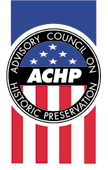 About ACHP
About ACHP ACHP News
National Historic
Preservation
Program
Working with
Section 106
Federal, State, & Tribal Programs
Training & Education
Publications
Search
Home
Section 106 Regulations Flow Chart
Click on parts of the flow chart for more information. (Flow chart best viewed in Netscape 4.0 or higher)
material in one long document—suitable for printing |
* The regulations define the term "THPO" as those tribes that have assumed SHPO responsibilities on their tribal lands and have been certified pursuant to Section 101(d)(2) of the NHPA. Nevertheless, remember that tribes that have not been so certified have the same consultation and concurrence rights as THPOs when the undertaking takes place, or affects historic properties, on their tribal lands. The practical difference is that during such undertakings, THPOs would be consulted in lieu of the SHPO, while non-certified tribes would be consulted in addition to the SHPO.
Updated February 12, 2001

